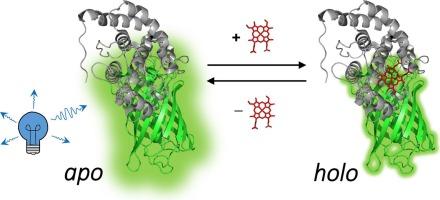基因编码血红素传感器的多光子荧光寿命成像
IF 3.2
2区 化学
Q2 BIOCHEMISTRY & MOLECULAR BIOLOGY
引用次数: 0
摘要
基于基因编码的荧光传感器已成为测量血红素丰度、揭示其运输途径以及探测其在细胞中的信号传导和调节作用的重要工具。文献中描述了许多不同的传感器设计,这些传感器通常通过荧光蛋白报告器发射的强度调制来报告可交换血红素的丰度。在这里,我们展示了多光子荧光寿命成像显微镜(MP-FLIM)可用于监测转染hek293细胞中血红素传感器的反应。采用多光子方法可以将血红素定量进一步扩展到未来的深部组织成像,在那里它还可以减少光毒性,因为荧光报告的非线性激发仅限于焦点体积。本文章由计算机程序翻译,如有差异,请以英文原文为准。

Multi-photon fluorescence-lifetime imaging of a genetically-encoded heme sensor
Genetically-encoded fluorescence-based sensors have emerged as an essential tool for measuring the abundance of heme, revealing its trafficking pathways, and probing its signalling and regulatory role in cells. A number of different sensor designs have been described in the literature, and these typically report on the abundance of exchangeable heme via an intensity modulation of the emission from fluorescent-protein reporters. Here, we show that multi-photon fluorescence-lifetime imaging microscopy (MP-FLIM) can be used to monitor the response of heme sensors in transfected-HEK293 cells. The adoption of a multi-photon approach could extend heme quantification further to deep-tissue imaging in the future, where it could also reduce phototoxicity as the non-linear excitation of fluorescent reporters is confined to the focal volume.
求助全文
通过发布文献求助,成功后即可免费获取论文全文。
去求助
来源期刊

Journal of Inorganic Biochemistry
生物-生化与分子生物学
CiteScore
7.00
自引率
10.30%
发文量
336
审稿时长
41 days
期刊介绍:
The Journal of Inorganic Biochemistry is an established international forum for research in all aspects of Biological Inorganic Chemistry. Original papers of a high scientific level are published in the form of Articles (full length papers), Short Communications, Focused Reviews and Bioinorganic Methods. Topics include: the chemistry, structure and function of metalloenzymes; the interaction of inorganic ions and molecules with proteins and nucleic acids; the synthesis and properties of coordination complexes of biological interest including both structural and functional model systems; the function of metal- containing systems in the regulation of gene expression; the role of metals in medicine; the application of spectroscopic methods to determine the structure of metallobiomolecules; the preparation and characterization of metal-based biomaterials; and related systems. The emphasis of the Journal is on the structure and mechanism of action of metallobiomolecules.
 求助内容:
求助内容: 应助结果提醒方式:
应助结果提醒方式:


